Factorisation Quadratic Polynomial
Polynomial of Class 9
FACTORISATION QUADRATIC POLYNOMIAL
For factorisation of a quadratic expression ax2 + bx + a where a ≠ 0, there are two method.
(a) By Method of Completion of Square :
In the form ax2 + bx + c where a ≠ 0, firstly we take ‘a’ common in the whole expression then factorise by converting the expression  as the difference of two squares.
as the difference of two squares.
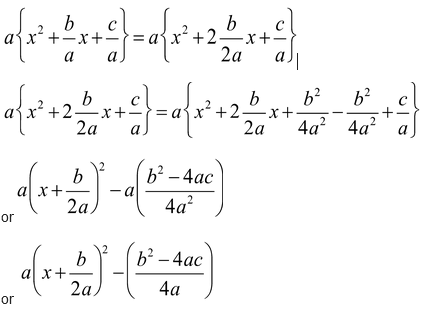
Question Factorize x2– 31x + 220.
Solution: x2– 31a + 220
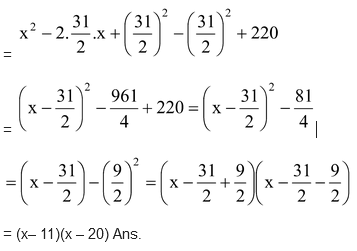
Question Factorize: –10x2 + 31x – 24
Solution:
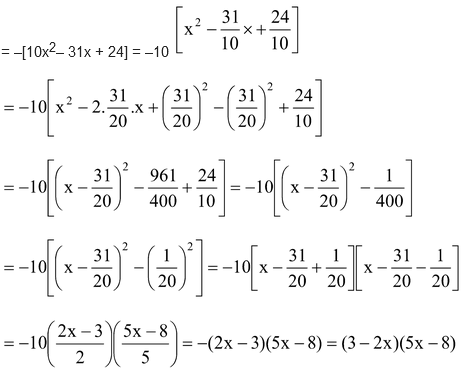
Question 81a2b2c2+ 64a6b2– 144a4b2c
Solution: 81a2b2bc2 + 64a6b2– 144a4b2c
= [9abc] 2– 2 [9abc][8a3b] + [8a3b]2
= [9abc –8a3b]2 = a2b2 [9c – 8a2]2 Ans.
Question 
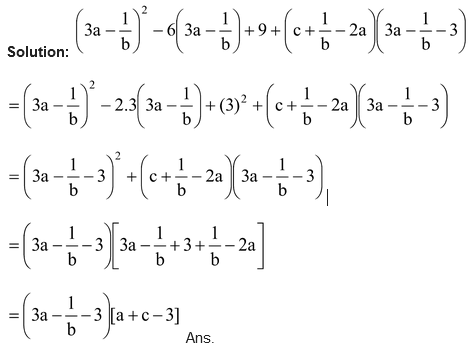
(b) By Splitting the Middle Term:
In the quadratic expression ax2 + bx + c, where a is the coefficient of x2, b is the coefficient of x and c is the constant term. In the quadratic expression of the form x2 + bx + c, a = 1 is the multiple of x2 and another terms are the same as above.
There are four types of quadratic expression with respect to to the sign change of coefficients of x and constant term :
(i) ax2 + bx + c (ii) ax2– bx + c
(iii) ax2– bx – c (iv) ax2 + bx – c
Splitting middle term of ax2 + bx +c.
In this case, we find integers s and t such that s + t = b and st = ac.
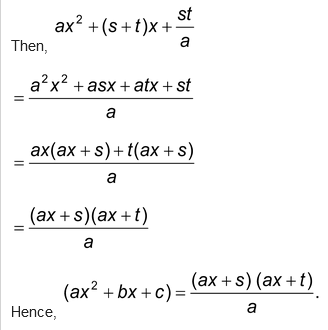
Question Factorize:  .
.
Solution: Here 
We try to split 5x into two parts whose sum is 5 and product is = –24
Clearly, 8 + (–3) = 5 and 8 × –3 = –24
Middle term 5x can be written as 8x - 3x
∴
Question Find the value of q, if X + 3 is a factor of 
Solution: Let  be the given polynomial. According to question (X+3) is a factor of p(x)
be the given polynomial. According to question (X+3) is a factor of p(x)
∴ we have p(-3)= 0
⇒ 
Ex. Factorize: 2x2 + 12 + 35.
+ 35.
Sol. 2x2 + 12 + 35
+ 35
Product ac = 70 & b = 12
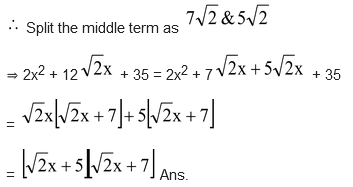 .
.
Question Factorize: x2 – 14x + 24.
Solution: Product ac = 24 & b = -14
∴ Split the middle term as – 2 &– 2
⇒ x2– 14x + 24 = x2– 12 – 2x + 24
⇒ x(x – 12) – 2 (x – 12) = (x – 12)(x – 2) Ans.
Question Factorize: 
Solution: 
Product ac = – 48 & b = – 13 ∴ We split the middle term as – 16x + 3x.
=1/24[24x2– 16x + 3x – 2]
=1/24[8x(3x – 2) + 1(3x – 2)]
=1/24(3x – 2)(8x + 1) Ans.
Question Factorize:
Solution: 
 Ans.
Ans.
Question Factorize: 
Solution: The given expression is 
We try to split 9 into two parts whose sum is 9 and product 18.
Clearly, 6 + 3 = 9 and 6 × 3 = 18.
∴ 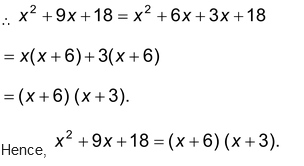
Question Factorize:  by splitting the middle term:
by splitting the middle term:
Solution: In order to factorize  we try to split 3√3 into two parts whose sum is 3√3 and product is 6.
we try to split 3√3 into two parts whose sum is 3√3 and product is 6.
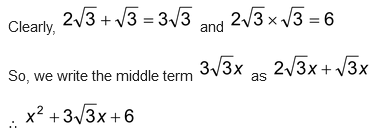
So, we write the middle term 3√3 as 2√3x + √3x

(c) Factorisation by Using the Formula for the Difference of Two Squares:
a2– b2 = ( a + b) (a - b)
Ex. Factorise:4(2a + 3b – 4c) 2– (a – 4b + 5c)2
Solution: = 4(2a + 3b –4c)2– (a – 4b + 5c) 2
= [2(2a + 3b – 4c)]2– (a – 4b + 5c)2
= [4a + 6b – 8c + a – 4b + 5c] [4a + 6b – 8c – a + 4b – 5c]
= [5a + 2b – 3c] [3a + 10b – 13c] Ans.
Question Factorise :
Solution: 
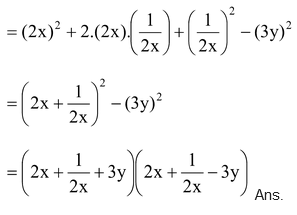
Question Factorize: 
Solution: 
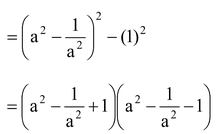 Ans.
Ans.
Question Factorize: x4 + x2y2 + y4.
Sol. x2 + x2y2 + y4 = (x2) 2 + 2.x2.y2 + (y2)2– x2y2
= x2 + y2)2– (xy)2
= (x2 + y2 + xy) (x2 + y2– xy) Ans.
(d) Factorization by Using Formula of a3 + b3 and a3– b3:
Ex. Factorize: 64a13b + 343ab13.
Solution: 64a13b + 343ab13 = ab[64a12 + 343b12]
= ab[(4a4)3 + (7b4)3]
= ab[4a4 + 7b4] [(4a4)2– (4a4) (7b4) + (7b4)2]
= ab[4a4 + 7b4][16a8– 28a4b8 + 49b8] Ans.
Question Factorize: p3q2x4 + 3p2qx3 + 3px2 + X/q– q2r3x
Solution: In above question, If we take common then it may become in the form of 3 + b3.
p3q2x4 + 3p2qx3 + 3px2 + X/q– q2r3x
= X/q[p3q3x3 + 3p2q2x2 + 3pqx + 1 – q3r3]
= X/q[(pqx)3 + 3(pqx)2 .1 + 3pqx . (1)2 + (1)3– q3r3]
Let pqx = A & 1 = B
= X/q [A3 + 3A2B + 3AB2 + B3– q3r3]
= X/q[(pqx + 1)3– (qr)3] = X/q[pqx + 1 – qr][(pqx + 1)2 + (pqx + 1) qr + (qr)3]
= X/q[pqx + 1 – qr][p2q2x2 + 1 + 2pqx + pq2xr + qr + q2r2] Ans.
Question Factorize: x3– 6x2 + 32
Solution: x3 + 32 – 6x2
= x3 + 8 + 24 – 6x2
= [(x)3 + (2)3] + 6[4 – x2]
= (x + 2)[x2– 2x + 4] + 6[2 + x][2 – x]
= (x + 2) [x2– 2x + 4 + 6(2 – x)]
= (x + 2)[x2– 2x + 4 + 12 – 6x]
= (x + 2) [x2– 8x + 16]
= (x + 2) (x – 4)2 Ans.
(e) Integral Root Theorem :
If f(x) is a polynomial with integral coefficient and the leading coefficient is 1, then any integer root of f(x) is a factor of the constant term. Thus if f(x) = x3– 6x2 + 11x - 6 has an Integral root, then it is one of the factors of 6 which are  .
.
Now Infect f(1) = (1)3– 6(1)2 + 11(1) – 6 = 1 – 6 + 11 – 6 =0
f(2) = (2)3– 6(2)2 + 11(2) – 6 = 8 – 24 + 22 – 6 = 0
f(3) = (3)3– 6(3)2 + 11(3) – 6 = 27 – 54 + 33 – 6 = 0
Therefore Integral roots of f(x) are 1,2,3.
(f) Rational Root Theorem :
Let b/c be a rational fraction in lowest terms. If b/c is a root of the polynomial f(x) =  with integral coefficients. Then b is a factor of constant term a0 and c is a factor of the leading coefficient an.
with integral coefficients. Then b is a factor of constant term a0 and c is a factor of the leading coefficient an.
For example :If b/c is a rational root of the polynomial f(x) = 6x3 + 5x2– 3x – 2, then the values of b are limited to the factors of –2 which are  and the value of c are limited to the factors of 6, which are
and the value of c are limited to the factors of 6, which are  Hence, the possible rational roots of f(x) are
Hence, the possible rational roots of f(x) are  Infect -1 is a Integral root and 2/3,-1/2 are the rational roots of f(x) = 6x3 + 5x2– 3x – 2.
Infect -1 is a Integral root and 2/3,-1/2 are the rational roots of f(x) = 6x3 + 5x2– 3x – 2.
NOTE:
(i) An nth degree polynomial can have at most n real roots.
(ii) Finding a zero or root of polynomial f(x) means solving the polynomial equation f(x) = 0. It follows from the above discussion that if f(x) = ax + b, a ≠ 0 is a linear polynomial, then it has only one root given by f(x) = 0 i.e. f(x) = ax + b = 0
⇒ ax = – b
⇒ x = 
Thus a=  is the only root of f(x) = ax + b.
is the only root of f(x) = ax + b.
Question If f(x) = 2x3– 13x2 + 17x + 12 then find out the value of f(-2) & f(3).
Solution: f(x) = 2x3– 13x2 + 17x + 12
f(-2) = 2(–2)3– 13(–2)2 + 17 (–2) + 12
= –16 – 52 – 34 + 12 = – 90 Ans.
f(3) = 2(3)3– 13(3)2 + 17(3) + 12
= 54 – 117 + 51 + 12 = 0 Ans.
(f) Factorisation of an Expression Reducible to a Quadratic Expression :
Question Factorize:- 8 + 9(a – b)6– (a – b)12
Solution: –8 + 9(a –b)6– (a – b)12
Let (a –b)6 = x
Then –8 + 9x – x2 = – (x2– 9x + 8) = – (x2– 8x – x + 8)
= – (x– 8)(x – 1)
= – [(a– b)6– 8][(a – b)6– 1]
= [1 – (a –b)6][(a – b)6– 8]
= [(1)3– {(a – b)2}3][{(a – b)2}3– (2)3]
= [1 – (a –b)2][1 + (a – b)4 + (a – b)2][(a – b)2– 2][(a – b)4 + 4 + 2(a – b)2] Ans.
Question Factorize: 6x2– 5xy – 4y2 + x + 17y – 15
Solution: 6x2 + x[1 – 5y] – [4y2– 17y + 15]
= 6x2 + x[1 – 5y] – [4y2– 17y + 15]
= 6x2 + x[1 – 5y] – [4y(y – 3) – 5(y – 3)]
= 6x2 + x[1 – 5y] – (4y – 5)(y – 3)
= 6x2 + 3(y –3)x– 2(4y – 5)x – (4y –)(y - 3)
= 3x[2x + y 3] - (4y - 5)(2x + y - 3)
= (2x + y - 3)(3x - 4y + 5) Ans.









